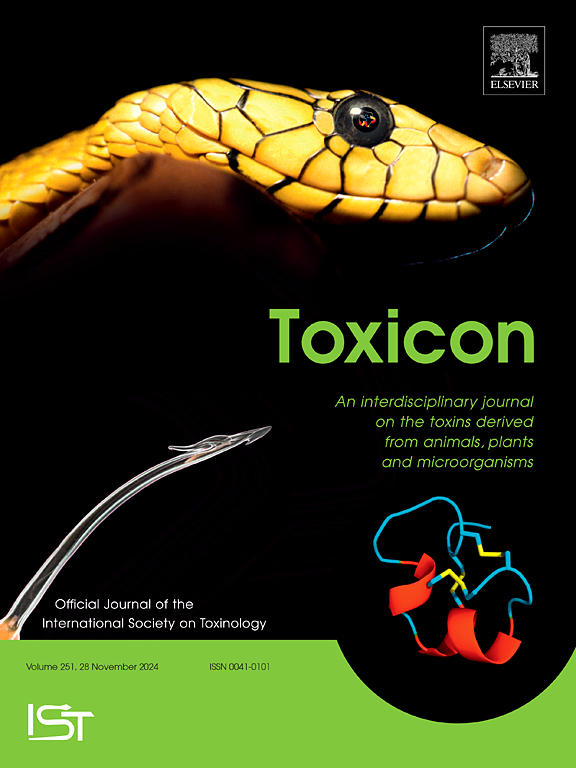The double-banded false coralsnake Erythrolamprus bizona (Dipsadidae, Xenodontinae, Xenodontini) has a metalloproteinase-rich venom with proteolytic activity towards azocasein and α-fibrinogen
IF 2.6
4区 医学
Q2 PHARMACOLOGY & PHARMACY
引用次数: 0
Abstract
The venom of the double-banded false coralsnake, Erythrolamprus bizona, is proteolytic and attenuates neuromuscular contractile activity in vitro. Here, we examined the Duvernoy's venom gland histology and general composition of E. bizona venom using a combination of chromatographic, electrophoretic, enzymatic and proteomic analyses. Histologically, the venom gland consisted of serous epithelium-lined secretory tubules and a supralabial gland that stained positively for mucopolysaccharide. SDS-PAGE showed that the venom had a simple composition, with proteins in the range of 15–60 kDa. This simple composition was confirmed by RP-HPLC that revealed 15 main protein peaks. The venom (1–10 μg) was highly proteolytic towards azocasein, but was devoid of esterase, phospholipase (PLA2), and L-amino acid oxidase activities. The venom also degraded casein and gelatin in zymographic assays, with activity towards gelatin being particularly potent and detected over the range of 18.7 ng–30 μg of venom; gelatinolytic activity was also detected in four of the RP-HPLC peaks. The venom (10 μg) selectively degraded the α-chain of fibrinogen. All proteolytic activity was inhibited by EDTA (metalloproteinase inhibitor) but not by AEBSF (serine proteinase inhibitor). SDS-PAGE followed by in-gel digestion of the main electrophoretic bands coupled with LC-MS/MS analysis revealed the presence of five toxin families: C-type lectin-like proteins (CTL), cysteine-rich secretory proteins (CRiSP), phospholipase B (PLB), snake venom matrix metalloproteinases (svMMP), and snake venom metalloproteinases (SVMP). These findings extend our knowledge of the toxinology of E. bizona and suggest that the local manifestations (pain, edema, erythema, and ecchymosis) seen in human envenomation by this species are probably mediated by venom metalloproteinases.
双带假珊瑚蛇(Dipsadidae, Xenodontinae, Xenodontini)具有富含金属蛋白酶的毒液,对偶氮酪蛋白和α-纤维蛋白原具有蛋白水解活性。
双带假珊瑚蛇(Erythrolamprus bizona)的毒液具有蛋白水解作用,并在体外减弱神经肌肉收缩活性。在这里,我们使用色谱、电泳、酶和蛋白质组学分析相结合的方法检查了杜氏毒液腺的组织学和一般组成。在组织学上,毒液腺由浆液上皮内衬的分泌小管和粘多糖染色阳性的唇上腺组成。SDS-PAGE分析结果显示,该毒液成分简单,蛋白质含量在15-60 kDa之间。通过反相高效液相色谱(RP-HPLC)鉴定出15个主要蛋白峰。毒(1 ~ 10 μg)对偶氮酪蛋白具有高度的蛋白水解作用,但缺乏酯酶、磷脂酶(PLA2)和l -氨基酸氧化酶活性。在酶谱分析中,该毒液还能降解酪蛋白和明胶,对明胶的活性特别强,在18.7 ng-30 μg的范围内检测到;在四个反相高效液相色谱峰中也检测到明胶水解活性。毒液(10 μg)选择性降解纤维蛋白原α-链。金属蛋白酶抑制剂EDTA对所有蛋白水解活性均有抑制作用,而丝氨酸蛋白酶抑制剂AEBSF无抑制作用。SDS-PAGE、凝胶内酶切和LC-MS/MS分析显示存在5个毒素家族:c型凝集素样蛋白(CTL)、富含半胱氨酸的分泌蛋白(CRiSP)、磷脂酶B (PLB)、蛇毒基质金属蛋白酶(svMMP)和蛇毒金属蛋白酶(SVMP)。这些发现扩展了我们对比索那毒杆菌毒理学的认识,并提示该物种在人类中毒中所见的局部表现(疼痛、水肿、红斑和瘀斑)可能是由毒液金属蛋白酶介导的。
本文章由计算机程序翻译,如有差异,请以英文原文为准。
求助全文
约1分钟内获得全文
求助全文
来源期刊

Toxicon
医学-毒理学
CiteScore
4.80
自引率
10.70%
发文量
358
审稿时长
68 days
期刊介绍:
Toxicon has an open access mirror Toxicon: X, sharing the same aims and scope, editorial team, submission system and rigorous peer review. An introductory offer Toxicon: X - full waiver of the Open Access fee.
Toxicon''s "aims and scope" are to publish:
-articles containing the results of original research on problems related to toxins derived from animals, plants and microorganisms
-papers on novel findings related to the chemical, pharmacological, toxicological, and immunological properties of natural toxins
-molecular biological studies of toxins and other genes from poisonous and venomous organisms that advance understanding of the role or function of toxins
-clinical observations on poisoning and envenoming where a new therapeutic principle has been proposed or a decidedly superior clinical result has been obtained.
-material on the use of toxins as tools in studying biological processes and material on subjects related to venom and antivenom problems.
-articles on the translational application of toxins, for example as drugs and insecticides
-epidemiological studies on envenoming or poisoning, so long as they highlight a previously unrecognised medical problem or provide insight into the prevention or medical treatment of envenoming or poisoning. Retrospective surveys of hospital records, especially those lacking species identification, will not be considered for publication. Properly designed prospective community-based surveys are strongly encouraged.
-articles describing well-known activities of venoms, such as antibacterial, anticancer, and analgesic activities of arachnid venoms, without any attempt to define the mechanism of action or purify the active component, will not be considered for publication in Toxicon.
-review articles on problems related to toxinology.
To encourage the exchange of ideas, sections of the journal may be devoted to Short Communications, Letters to the Editor and activities of the affiliated societies.
 求助内容:
求助内容: 应助结果提醒方式:
应助结果提醒方式:


